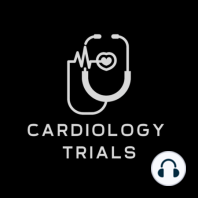7 min listen
Review of the OASIS-6 trial
ratings:
Length:
9 minutes
Released:
Mar 26, 2024
Format:
Podcast episode
Description
JAMA. 2006;295(13):1519-1530Background Previous trials demonstrated that aspirin and thrombolytic therapy improve prognosis in patients with ST elevation myocardial infarction (STEMI). The addition of heparin to aspirin and thrombolysis did not improve outcomes in patients with STEMI (see GISSI-2 trial). Fondaparinux, a synthetic pentasaccharide that inhibits factor Xa, was tested in OAISIS-5, and was found to be noninferior to enoxaparin in patients with acute coronary syndrome (without STEMI) and was associated with less bleeding.Cardiology Trial’s Substack is a reader-supported publication. To receive new posts and support my work, consider becoming a free or paid subscriber.The Sixth Organization for the Assessment of Strategies for Ischemic Syndromes (OASIS-6) trial sought to test the hypothesis that fondaparinux is superior to the standard of care in patients with STEMI.Patients Patients were enrolled if they had STEMI and were within 24 hours from onset of symptoms. The time window was later shortened to 12 hours. Patients at high risk for bleeding (this was not clearly defined), receiving oral anticoagulants or who had serum creatinine levels greater than 3.0 mg/dL were excluded.Baseline characteristics The trial enrolled 12,092 patients. The average age of patients was 62 years and 72% were men. The mean heart rate and systolic blood pressure on admission were 76 bpm and 134 mm Hg, respectively. About half had hypertension, 18% had diabetes, 14% had heart failure, 13% had prior myocardial infarction, 7% had prior stroke, and 4% had prior coronary artery bypass graft or percutaneous coronary intervention (PCI). About 58% were active or former smokers. In-hospital medications, after randomization, included aspirin in 97% of the patients, beta-blockers in 84%, ACEi or ARB in 80%, clopidogrel or ticlopidine in 58% and glycoprotein IIb/IIIa receptor antagonist in 16%.During the index hospitalization, coronary angiography was performed in about 44% of the patients but primary percutaneous coronary intervention was performed in 31%. Thrombolytic therapy was given in 45% of the patients.Procedures OASIS-6 was a randomized double-blind trial. Patients were divided into two groups based on the investigator’s judgment - Group 1: No indication for heparin and group 2: Indication for heparin, thrombolysis or PCI. Patients in group 1 received fondaparinux 2.5 mg subcutaneously once daily or matching placebo. Patients in group 2 received fondaparinux 2.5 mg subcutaneously once daily + heparin placebo or heparin + fondaparinux placebo. For patients who received heparin, an initial bolus of 60 IU/kg was given followed by an infusion of 12 IU/kg per hour for 24-48 hours. A placebo bolus and continuous infusion were used in the fondaparinux group, in group 2. Fondaparinux was given for 8 days or until hospital discharge, or whichever came first. To maintain blinding, all patients in group 2 had aPTT checked and a central system produced either a real or sham value.Endpoints The primary efficacy endpoint was all-cause death or reinfarction at 30 days. Secondary endpoint was the primary endpoint at 9 days, and at 3 and 6 months (only half the patients were followed for 6 months). Safety endpoints included major and minor bleeding. Based on an event rate of 8% at 9 days, the estimated sample size to have 90% power to detect 20% relative risk reduction with fondaparinux was 10,000. However, after 8,000 patients were enrolled, the event rate was lower than expected so the sample size was increased to 12,000 and the primary endpoint was changed to 30 days.Results The study assigned 6,036 patients to the fondaparinux group and 6,056 to control group. The fondaparinux group included 2,823 patients from group 1 and 3,213 patients in group 2. The control group included 2,835 patients in group 1 and 3,221 patients in group 2.Death or reinfarction was lower with fondaparinux at 9 days (7.4% vs. 8.9%, HR: 0.83, 95% CI: 0.73 – 0.94; p= 0.003), at 30
Released:
Mar 26, 2024
Format:
Podcast episode
Titles in the series (40)
Review of the Cardiac Arrhythmia Suppression Trial (CAST) by Cardiology Trials
